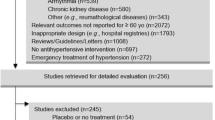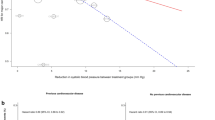Abstract
A number of trials and meta-analyses have demonstrated clear benefits of blood pressure (BP) reduction in patients aged <80 years with regard to the reduction in stroke and cardiovascular events. However, a variety of studies have suggested that the positive relationship between BP and cardiovascular mortality is weakened or indeed reversed in the very elderly. Most intervention trials to date have either excluded or not recruited sufficient patients aged ≥80 years to determine whether there is a significant benefit from treatment in this age group. A meta-analysis of intervention trials that recruited patients aged ≥80 years has suggested a benefit in terms of stroke reduction but has also raised the possibility of an increase in total mortality. The benefit to risk ratio therefore needs to be clearly established before recommendations can be made for treating very elderly patients with hypertension.
The Hypertension in the Very Elderly Trial (HYVET) pilot recruited 1283 patients aged ≥80 years and showed the feasibility of performing such a trial in this age group. It was a Prospective Randomised Open Blinded End-Points (PROBE) design but the main trial has additional pharmaceutical sponsorship to run a double-blind trial. Therefore, the main trial is a randomised, double-blind, placebo-controlled trial designed to assess the benefits of treating very elderly patients with hypertension. It compares placebo with a low dose diuretic (indapamide sustained release 1.5mg daily) and additional ACE inhibitor (perindopril) therapy if required.
As in the pilot trial, the primary end-point is stroke events (fatal and non-fatal) and the trial is designed to determine whether or not a 35% difference occurs between placebo and active treatment. The main objective will be achieved with 90% power at the 1% level of significance. Secondary outcome measures will include total mortality, cardiovascular mortality, cardiac mortality, stroke mortality and skeletal fracture.
2100 patients aged ≥80 years are to be recruited and followed up for an average of 5 years. Entry BP criteria after 2 months of a single-blind placebo run-in period are a sustained sitting systolic BP (SBP) of 160 to 199mm Hg and a diastolic BP of 90 to 109mm Hg. The standing SBP must be >140mm Hg. The trial will be carried out in accordance with the principles of Good Clinical Practice. We describe in detail the protocol for the main trial and discuss the reasons for the changes from the pilot, the use of the drug regimen, and the BP criteria to be used in the trial.
Similar content being viewed by others
References
Medical Research Council Working Party. MRC trial of treatment of hypertension in older adults: principal results. BMJ 1992; 304: 405–12
Coope JN, Warrender TS. Randomised trial of hypertension in elderly patients in primary care. BMJ 1986; 293: 1145–51
Amery A, Birkenhäger WH, Brixko P, et al. Mortality and morbidity results from the European Working Party on High blood pressure in the Elderly trial. Lancet 1985; I: 1349–54
Dahlof B, Lindholm LH, Hanson L, et al. Morbidity and mortality in the Swedish trial in old patients with hypertension (STOP-Hypertension). Lancet 1991; 338: 1281–5
Systolic Hypertension in the Elderly (SHEP) Programme Cooperative Research Group. Prevention of stroke by anti-hypertensive drug treatment in older persons with isolated systolic hypertension. JAMA 1991; 265: 3255–64
Staessen JA, Fagard R, Thijs L, et al. Randomised double-blind comparison of placebo and active treatment for older patients with systolic hypertension. Lancet 1997; 350: 757–764
Thijs L. Fagard R, Linjnen P, et al. A meta-analysis of outcome trials in elderly hypertensives. J Hypertens 1992; 10: 1103–9
Insua JT, Sacks HS, Lau TS, et al. Drug treatment of hypertension in the elderly: a meta-analysis. Ann Intern 1994; 121: 355–62
Sanderson S. Hypertension in the elderly: pressure to treat? Health Trends 1996; 28: 117–21
Mattila K, Haavisto M, Rajala S, Heikinheimo R. Blood pressure and survival in the very old. BMJ 1988; 296: 887–9
Lindholm L, Schersten B, Thulin T. High blood pressure and mortality in the elderly. Lancet 1982; 2: 745–6
Boshuizen HC, Izaks GJ, van Buuren S, et al. Blood pressure and mortality in elderly people aged 85 and older: community based study. BMJ 1998; 316: 1780–4
Gueyffier F, Bulpitt C, Boissel J-P, et al. Antihypertensive treatment in very old people: a subgroup meta-analysis of randomised controlled trials. Lancet 1999; 353; 793–6
Guidelines Subcommittee. 1999 World Health Organization-International Society of Hypertension guidelines for the management of hypertension. J. Hypertension 1999; 17: 151–183
Bulpitt CJ, Fletcher AE, Amery A, et al. The hypertension in the Very Elderly Trial (HYVET): rationale, methodology and comparison with previous trials. Drugs Aging 1994; 5: 171–83
Staessen JA, Gaswoski J, Wang JG, et al. Risks of untreated and treated isolated systolic hypertension in the elderly: meta-analysis of outcome trials. Lancet 2000; 355: 865–72
O’Brien E, Petrie J, Littler WA, et al. The British Hypertension Society Protocol for the evaluation of blood pressure measuring devices. J. Hypertens 1993; IISuppl. 2: S43–63
MacFadyen RJ, Lees KR, Reid JL. Differences in first dose response to angiotensin converting enzyme inhibition in congestive heart failure: a placebo controlled study. Br Heart J 1991; 66: 206–211
MacFadyen RJ, Squire IB, Reid JL, et al. Differing early blood pressure and renin-angiotensin system responses to the first dose of angiotensin-converting enzyme inhibitors in congestive heart failure. J Cardiovasc Pharmacol 1996; 27: 657–66
Katzman R, Brown T, Fuld P, et al. Validation of a short orientation-memory-concentration Test of cognitive impairment. Am J Psych 1983; 140: 734–9
Folstein W, Folstein SE, McHugh RP. ‘Mini Mental State’: a practical method for grading the cognitive state of patients for the clinician. J Psychiatr Res: 1975; 12: 189–98
World Health Organization. International classification of diseases. 10th revision. Geneva: World Health Organization, 1993
Ebrahim S. Clinical epidemiology of stroke. Oxford University Press: Oxford, 1990
O’Brien PC, Fleming TR. A multiple testing procedure for clinical trials. Biometrics 1979; 35: 549–556
Mathias S, Bates M, Pasta D, et al. Use of Health Utilities Index with stroke patients and their caregivers. Stroke 1997; 10: 1888–94
Hansson L, Lindholm LH, Ekbom T, et al. Randomised trial of old and new antihypertensive drugs in elderly patients: cardiovascular mortality and morbidity the Swedish Trial in Old Patients with Hypertension-2 study. Lancet 1999; 354: 1751–6
Hansson L, Zanchetti A, Carruthers SG, et al. Effects of intensive blood-pressure lowering and low-dose aspirin in patients with hypertension: principal results of the Hypertension Optimal Treatment (HOT) randomised trial. HOT Study Group. Lancet 1998; 351(9118): 1755–62
Bulpitt CJ. Randomised controlled clinical trials. 2nd ed. London: Kluwer Academic Publishers, 1996
Ederer F Patients bias, investigator bias and the double-masked procedure in clinical trials. Am J Med 1975; 58: 295–9
Beecher HK. The powerful placebo. JAMA 1955; 159: 1602–6
Antihypertensive and Lipid Lowering treatment to prevent Heart Attack (ALLHAT) Collaborative Research Group. Major cardiovascular events in hypertensive patients randomised to doxasozin vs. chlorthalidone: the antihypertensive and lipid lowering treatment to prevent heart attack trial (ALLHAT). JAMA 2000; 283: 1967–75
The sixth report of the Joint National Committee on prevention, detection, evaluation, and treatment of high blood pressure [published erratum appears in Arch Intern Med 1998 Mar 23; 158 (6): 573)]. Arch Intern Med 1997; 157: 2413–46
Ambrosioni E, Safar M, Degaute JP, et al. Low-dose antihypertensive therapy with 1.5 mg sustained-release indapamide: results of randomized double-blind controlled studies. J Hypertens 1998; 16: 1677–84
Harrower ADB, McFarlane G. Antihypertensive therapy in diabetic patients: the use of indapamide. Am J Med 1988; 84: 89–91
Raggi U, Palumbo P, Moro B, et al. Indapamide in the treatment of hypertension in non-insulin dependent diabetes. Hypertension 1985; 7 (6 Pt 2): II157–160
Gosse P, Sheridan DJ, Zannad F, et al. Regression of left ventricular hypertrophy in hypertensive patients treated with indapamide SR 1.5mg versus enalapril 20mg: the L.I.V.E. study. J Hypertens 2000; 18: 1465–75
Mallion JM, Asmar R, Boutelant S, et al. Twenty four hours antihypertensive efficacy of indapamide 1.5mg sustained-release: results of two randomized double-blind controlled studies. J Cardiovasc Pharmacol 1998; 32: 673–8
Guez D, Mallion JM, Degaute JP, et al. Low dose antihypertensive therapy with indapamide 1.5mg sustained release coated tablets: pooled data from two European multicenter randomized double blind studies in 690 patients. Arch Mal Coeur Vaiss 1996; 89: 17–26
Bulpitt CJ, Emeriau JP, Knauf H, et al. Equivalence study of antihypertensive effect of indapamide sustained-release (SR) 1.5mg, hydrochlorothiazide 25mg and amlodipine 5mg in hypertension [abstract]. J Hypertens 1997; 15Suppl. 4: S130
Poggi L, Renucci JF, Denolle T. Treatment of essential hypertension in general practice: an open-label study of 47 351 French hypertensive patients treated for one year with perindopril. Can J Cardiol 1994; 10Suppl. D: 21–4D
Thurston H, Desché P. Assessment of antihypertensive efficacy of perindopril: results of double-blind multicenter studies versus reference drugs. J Cardiovasc Pharmacol 1991; 18Suppl. 7: S45–9
Morgan T, Anderson A. Clinical efficacy of perindopril in hypertension. Clin Exp Pharmacol Physiol 1992; 19Suppl. 19: 61–5
Myers MG. A dose-response study of perindopril in hypertension: effects on blood pressure 6 and 24 hours after dosing. Perindopril Multicentre Dose-Response Study Group. Can J Cardiol 1996; 12: 1191–6
Suraniti S, Berrut G, Marre M, et al. Antihypertensive efficacy and acceptability of perindopril in elderly hypertensive patients. Am J Cardiol 1993; 71: 28E–31E
Santoni JP, Richard C, Pouyollon F, et al. Tolerance and safety of perindopril. Clin Exp Hypertens A. 1989; 11Suppl 2: 605–17
Ramsay LE, Williams B, Johnston GD, et al. Guidelines for management of hypertension: report of the third working party of the British Hypertension Society. J Hum Hypertens 1999; 13: 569–92
Coope J, Warrender TS, McPherson K. The prognostic significance of blood pressure in the elderly. J Hum Hypertens 1988; 2: 79–88
Taylor JO, Cornoni-Huntley J, Curb JD, et al. Blood pressure and mortality risk in the elderly. Am J Epidemiol 1991; 134: 489–501
Somes GW, Pahor M, Shorr RI, et al. The role of diastolic blood pressure when treating isolated systolic hypertension. Arch Intern Med 1999; 159: 2004–9
Acknowledgements
As with the pilot trial the main HYVET trial is funded by the charity, the British Heart Foundation. However, there is additional support from the Institut de Recherches Internationales Servier. The Imperial College, London, has arranged the insurance for the trial. The following investigators took part in the pilot trial:
England and Scotland: S. Bailey (Chaderton), H. Bethel (Alton), N. Coni (Cambridge), J. Coope (Macclesfield), N. Gainsborough (Brighton), G. Greveson (Newcastle), P. McCaffrey (Lurgan), P. Murdoch (Falkirk), Pandita-Gunawardena (London), J. Potter (Leicester), C. Rajkumar (London), S. Soloman, (Oldham), B. Williams (Glasgow).
Bulgaria: S. Beleva (Vidin), R. Kermova (Pleven), S. Mantov (Stara Zagora), E. Mantova (Sophia), C. Nachev (Sophia), D. Popov (Sophia), V. Sirakova (Varna), D. Smilkova (Sophia), P. Solakov (Plovdiv), V. Stoyanovsky (Sophia), T. Vasileva (Dobrich), D. Yankulova (Bankya).
Finland: R. Antikainen (Oulu).
Romania: S. Babeanu (Bucharest), D. Dumitrascu (Cluj).
Spain: B. Gil-Extremera (Granada).
Lithuania: J. Arlauskas (Trakuraj).
Ireland: J. Duggan (Dublin).
Poland: Z. Chodorouski (Gdansk), T. Grodzicki (Krakow).
Greece: A. Efstratopoulos (Athens).
Serbia: M. Davidovic (Belgrade).
The Committees and national coordinators of the main HYVET trial are:
Steering Committee: J. Coope, B. Gil-Extremera, F. Forette, C. Nachev, J. Potter, P. Sever, J. Staessen, C. Swift, J. Tuomilehto.
Monitoring and Statistical Committee: J. Staessen, (chairman), A. Fletcher, L. Thijs, J. Cooke.
End-Point Committee: C. Davidson, (Chairman), J. Duggan, N. Gainsborough, MC. de Vernejoul.
Ethics Committee: R. Fagard (Chairman), L Ramsay, J Grimley Evans.
National Coordinators: R. Warne/I. Puddey (Australia), H. Celis (Belgium), C. Nachev (Bulgaria), L. Lisheng (China), R Antikainen (Finland), F. Forette (France), J. Duggan (Ireland), G. Gensini (Italy), T. Grodzicki (Poland), G. Clara (Portugal), D.L. Dumitrascu (Romania), L.B. Lazebnik (Russia), B. Gil-Extremera (Spain), B. Williams (UK).
Lead Investigator: C. Bulpitt
Co-investigator: A. Fletcher
Trial Coordinator: N. Beckett
Coordinating Staff: M. Nunes (epidemiologist), J. Cooke (statistician), R. Peters, J. Astarci, J. Grove.
Author information
Authors and Affiliations
Corresponding author
Rights and permissions
About this article
Cite this article
Bulpitt, C., Fletcher, A., Beckett, N. et al. Hypertension in the Very Elderly Trial (HYVET). Drugs & Aging 18, 151–164 (2001). https://doi.org/10.2165/00002512-200118030-00001
Published:
Issue Date:
DOI: https://doi.org/10.2165/00002512-200118030-00001




